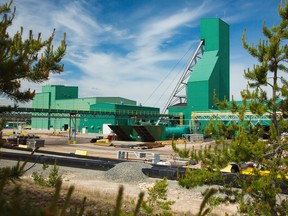
Cameco Corp.’s shares rose to their highest since mid-September after the Saskatoon-based uranium miner increased its production outlook thanks to what chief executive Tim Gitzel described as the “best fundamentals” the company has ever seen.
Gitzel on Feb. 9 reported an increase in longer term uranium contracts and a new agreement with Ukraine that could potentially be Cameco’s largest ever deal. The company’s bright prospects outweighed news that Cameco lost money in the fourth quarter.
“Nuclear is back on with a vengeance,” Gitzel said in an interview with BNN Bloomberg.
Cameco reported a net loss of $15 million in the quarter that ended Dec. 31, down from a profit of $11 million during the same period last year. The company attributed the loss to quarterly variations due to contract deliveries.
On year, Comeco recorded net profit of $89 million, up from a loss of $103 million in 2021, when the company was still feeling the effects of a tough decade following the Fukushima nuclear disaster in Japan in 2011 that put a chill on demand for nuclear energy globally.
But the scenario has changed in the past few years amid rising calls for the transition away from fossil fuels across the globe and the race to meet climate goals. For example, Justin Trudeau’s government said nuclear energy will play a “critical” role in lowering Canada’s emissions; on Oct. 25, it announced a $970-million commitment to build the country’s first small-scale nuclear power reactor at Darlington (Ontario) that’s expected to go online in 2028.

Small modular reactors (SMR) have one-third the power generating capacity of traditional nuclear power reactors, are a fraction of the size and are easier to build. Critics, however, say there are better alternatives than depending upon nuclear power, since it produces radioactive waste that can be harmful.
Russia’s invasion of Ukraine also led to a spike in demand for uranium. Russia supplied about 30 per cent of the world’s nuclear fuel, and that production is now subject to sanctions from western nations, creating opportunity for producers such as Cameco, Gitzel said.
Cameco inked a deal with Ukraine’s state nuclear energy provider Energoatom that will meet the country’s nuclear requirements until 2035, the miner said. Cameco said it expects to supply 40 to 68 million pounds of uranium during the period.
“It could be the largest single contract in the history of Cameco,” said Gitzel. “They have nine (nuclear units) operating today and six of them are under Russian control. So, we’ve obviously taken that into consideration.”
The Ukraine deal wasn’t included in the company’s 2022 numbers, which feature 80 million pounds worth of long-term uranium contracts, up from 30 million pounds in 2021. About 58 million of the 80 million have been finalized, while the remaining 22 million have almost been completed, the company said.
The company also plans to produce about 20 million pounds of uranium in 2023, which is almost twice the amount it produced in 2022. The 2023 production guidance is also about 35 per cent higher than Bank of Nova Scotia’s forecast for the year. Scotiabank analyst Orest Wowkodaw in a note to clients described Cameco’s results as “very positive,” despite the “mixed” fourth quarter.
“Overall, given the significantly stronger 2023 guidance and continued long-term contracting momentum, we view the update as very positive for the shares on a first look basis,” said Wowkodaw.
At midday, shares of Cameco were trading at $38.92, up $2.16 or 5.87 per cent, within a 52-week trading range of $24.59 and $41.05. The company has a market cap of about $16.8 billion.
• Email: [email protected] | Twitter: naimonthefield
You can read more of the news on source
